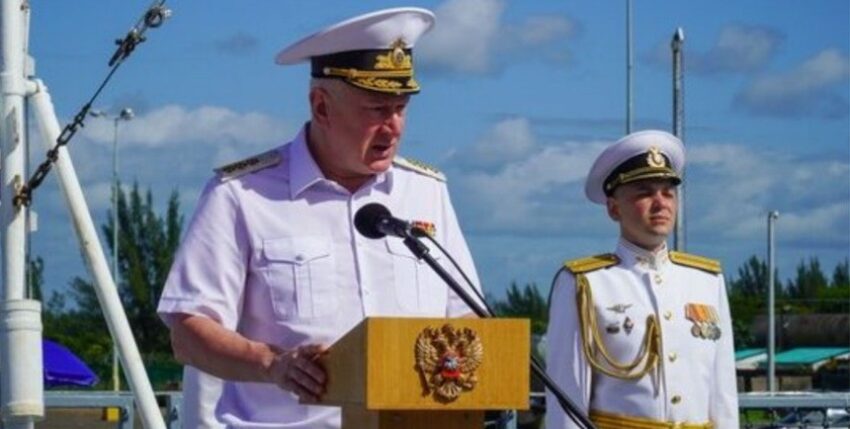Mosi II - the exercise name stands for smoke, vapour or fog - the trilateral exercise involving the Russian Navy, the Navy of the People's Liberation Army of China and the South African National Defence Forces ended on 27 February 2023 without the ultimate smoke production. As estimated by marineforum.online, the launch of a Zircon missile, which had been hyped up in advance, did not materialise.
As far as the Chinese and Russian participants in the exercise were concerned, the previous reports named units. In the end, the host was able to deploy the frigate "Mendi" (hull number F148).
Of the previously announced three South African naval participants, one unit thus remained, which can certainly be interpreted as an indication of the navy's operational capability. It is also an indication of the downward trend in the armed forces' budget, which is not without consequences for material and personnel clarity. While deficits in the staffing of posts and the individual training level of individual crew members were already evident during exercises such as Good Hope with the German Navy, the situation appears to have deteriorated further.
The operational parts of the exercise (25 - 27 February) read as follows in the official Russian report (Department of Information and Mass Communications of the Ministry of Defence of the Russian Federation, 27 February 2023): "For three days, the participants of the exercise worked out the formation of a multinational detachment of warships in the designated area, joint tactical manoeuvring in various formations and combat missions, mine defence tasks at sea crossings with firing at a target simulating a floating mine." The exercise catalogue also included target shooting, hostage rescue, sea rescue and man overboard. "In several episodes of the exercise, a Ka-27 ship helicopter was involved on board the Northern Fleet frigate "Admiral of the Soviet Union Fleet Gorshkov"," the Russian online communiqué said.
Political considerations
International observers were concerned about the exercise in the South African parts of the Indian Ocean, and not just because of the suspected use of the hypersonic weapon system. The opposition Democratic Alliance (DA) protested vehemently against the scheduling of the manoeuvre. The mayor of Cape Town (DA) argued against the arrival of the "Admiral Gorshkov" in his city. On 21 February, a new bill was submitted for discussion in the US Congress, which is basically directed against South Africa and explicitly addresses the exercises of the South African armed forces with the People's Republic of China and the Russian Federation.
The fact that Pretoria is not part of the anti-Russia front became clear with its voting behaviour in the Ukraine resolutions of the UN General Assembly. The Republic of the Cape of Good Hope was one of the abstainers in each case.
Africa: Away from the West?
The realisation of these exercises highlights the strategic transformation of the Black Continent, which is not only taking place in South Africa. The Russian naval presence in the Indian Ocean has steadily increased over the last ten years. Russia has conducted naval exercises in the northern Indian Ocean together with China and Iran. The expected military base in Bur Sudan on the Red Sea will increase Moscow's strategic reach and presence in Africa and beyond to the Middle East. Russia's Wagner Group mercenaries are deployed in West and Central Africa - not just to fight Islamist groups, but rather to influence rulers and manipulate them for Russian purposes.
However, Mosi II also shows that the isolation of Moscow in the global South, which the so-called West hoped would be the result of the invasion of Ukraine in violation of international law, is not bearing the expected fruit. In this respect, Russia is scoring points by sending the "Admiral Gorshkov" and using the frigate as a means of strategic communication. This was reinforced by the presence of the Commander-in-Chief of the Naval Forces of the Russian Federation, Admiral Nikolai Evmenov, on Defender of the Fatherland Day on 23 February.
On the other hand, Mosi II is another example of the growing Chinese naval presence in the Indian Ocean. China has maintained a military base in Djibouti since 2017 and maintains close relations with countries in the western Indian Ocean such as Kenya, Tanzania and Madagascar. The naval exercises with Russia and South Africa, the expansion of relations with Iran and Pakistan, the looming construction of a military base in Gwadar, Pakistan, and the announcement in January 2023 that a spaceport would be built in Djibouti: All of this not only points to the growing Chinese presence in the Indian Ocean, but also creates unrest in the strategic balance in the Indian Ocean as well as in Africa.
Indian voices are assessing exercises like Mosi's that geopolitics in the Indian Ocean is heading towards more uncertainty and change. The potential Sino-Russian strategic cooperation in the Indian Ocean has geopolitical implications not only for India but also for the other partners in the Quadrilateral Security Dialogue (Australia, Japan and the US).
France, on the other hand. Under the new Africa strategy, which was presented on 27 February, President Emmanuel Macron announced that France's new role in Africa will be less characterised by security and military issues. He wants a "transition from a logic of aid to a logic of investment in solidarity and partnership". This will take place over the next few months and will be accompanied by "a visible reduction in our personnel strength and a simultaneous increase in the presence of our African partners in these bases". France wants to move away from what it sees as the logic of putting its head down to ensure security while others do the business.











2 responses
Moin,
In the meantime, the Russian frigate "Admiral flota Sovetskogo Soyuza Gorshkov" ("Адмирал флота Советского Союза Горшков") has arrived off the Iranian coast accompanied by the medium-sized ocean-going tanker "Kama" ("Кама") to take part in the trilateral Russian-Chinese-Iranian exercise "Maritime Security Belt-2023".
The actions originate in Iran's only deep-water harbour, Chabahar.
On 16 and 17 March, exercises are carried out at sea, including artillery firing by day and night, assistance to ships in distress, rescue of hijacked ships and joint manoeuvres.
The Chinese Navy is participating with the guided missile destroyer "Nanjing" (Type 54D), while the Iranian naval forces are represented by the frigates "Sahand" and "Jamaran" and the corvette "Bayandor".
Thank you, Mr Engel, for your comments.
I had reacted. The publication in the MFO then took place as shown online. https://marineforum.online/china-iran-und-russland-gemeinsame-marineuebungen-im-golf-von-oman/
I don't always manage 'live' reporting. And then there's the editorial loop ...